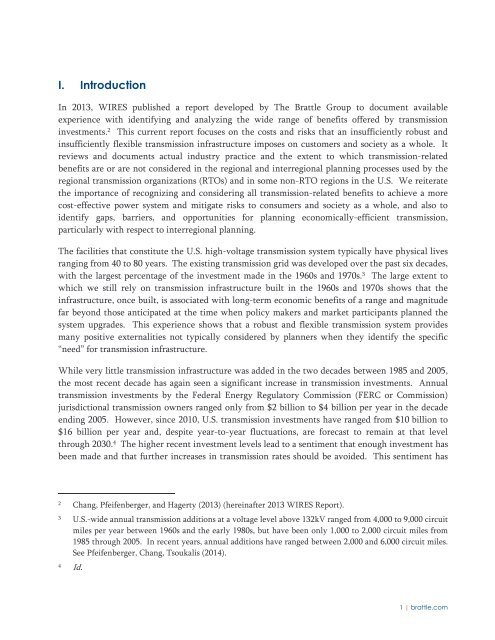THE BRATTLE GROUP
pvrbYG
pvrbYG
Create successful ePaper yourself
Turn your PDF publications into a flip-book with our unique Google optimized e-Paper software.
I. Introduction<br />
In 2013, WIRES published a report developed by The Brattle Group to document available<br />
experience with identifying and analyzing the wide range of benefits offered by transmission<br />
investments. 2 This current report focuses on the costs and risks that an insufficiently robust and<br />
insufficiently flexible transmission infrastructure imposes on customers and society as a whole. It<br />
reviews and documents actual industry practice and the extent to which transmission-related<br />
benefits are or are not considered in the regional and interregional planning processes used by the<br />
regional transmission organizations (RTOs) and in some non-RTO regions in the U.S. We reiterate<br />
the importance of recognizing and considering all transmission-related benefits to achieve a more<br />
cost-effective power system and mitigate risks to consumers and society as a whole, and also to<br />
identify gaps, barriers, and opportunities for planning economically-efficient transmission,<br />
particularly with respect to interregional planning.<br />
The facilities that constitute the U.S. high-voltage transmission system typically have physical lives<br />
ranging from 40 to 80 years. The existing transmission grid was developed over the past six decades,<br />
with the largest percentage of the investment made in the 1960s and 1970s. 3 The large extent to<br />
which we still rely on transmission infrastructure built in the 1960s and 1970s shows that the<br />
infrastructure, once built, is associated with long-term economic benefits of a range and magnitude<br />
far beyond those anticipated at the time when policy makers and market participants planned the<br />
system upgrades. This experience shows that a robust and flexible transmission system provides<br />
many positive externalities not typically considered by planners when they identify the specific<br />
“need” for transmission infrastructure.<br />
While very little transmission infrastructure was added in the two decades between 1985 and 2005,<br />
the most recent decade has again seen a significant increase in transmission investments. Annual<br />
transmission investments by the Federal Energy Regulatory Commission (FERC or Commission)<br />
jurisdictional transmission owners ranged only from $2 billion to $4 billion per year in the decade<br />
ending 2005. However, since 2010, U.S. transmission investments have ranged from $10 billion to<br />
$16 billion per year and, despite year-to-year fluctuations, are forecast to remain at that level<br />
through 2030. 4 The higher recent investment levels lead to a sentiment that enough investment has<br />
been made and that further increases in transmission rates should be avoided. This sentiment has<br />
2<br />
Chang, Pfeifenberger, and Hagerty (2013) (hereinafter 2013 WIRES Report).<br />
3<br />
U.S.-wide annual transmission additions at a voltage level above 132kV ranged from 4,000 to 9,000 circuit<br />
miles per year between 1960s and the early 1980s, but have been only 1,000 to 2,000 circuit miles from<br />
1985 through 2005. In recent years, annual additions have ranged between 2,000 and 6,000 circuit miles.<br />
See Pfeifenberger, Chang, Tsoukalis (2014).<br />
4<br />
Id.<br />
1 | brattle.com


